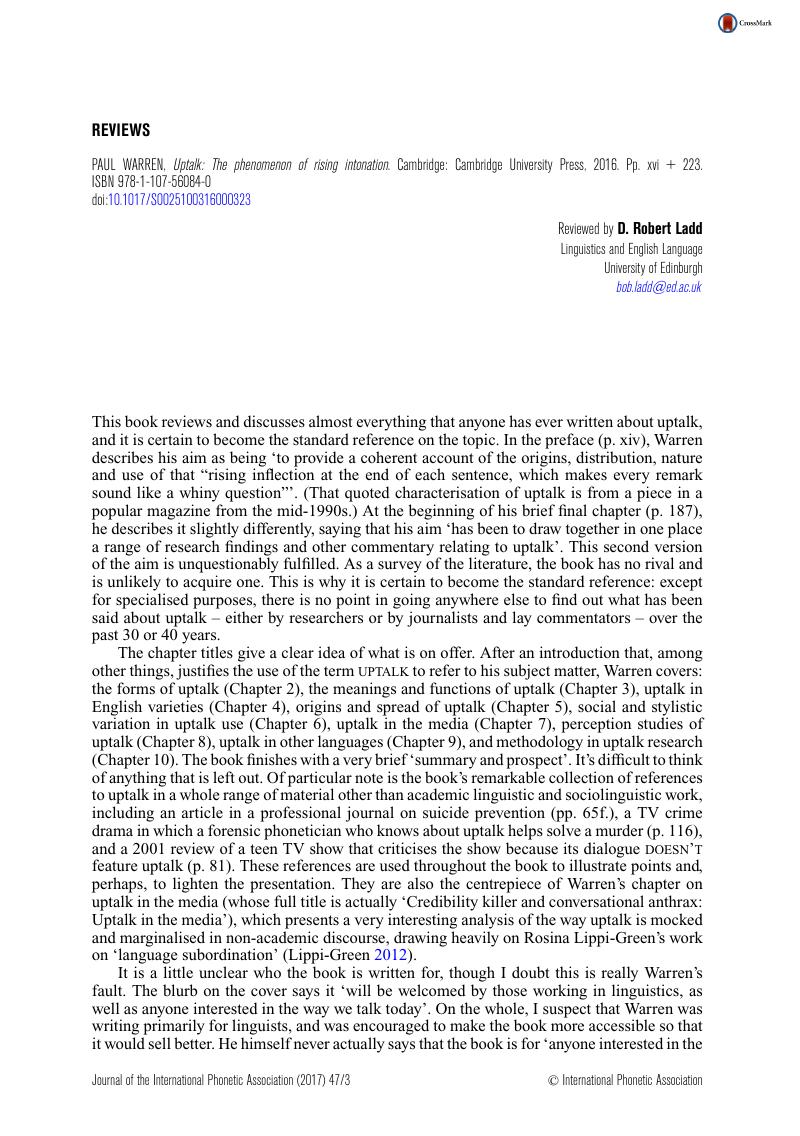No CrossRef data available.
Article contents
PAUL WARREN , Uptalk: The phenomenon of rising intonation. Cambridge: Cambridge University Press, 2016. Pp. xvi + 223. ISBN 978-1-107-56084-0
Published online by Cambridge University Press: 09 September 2016
Abstract
An abstract is not available for this content so a preview has been provided. Please use the Get access link above for information on how to access this content.

- Type
- Book Review
- Information
- Journal of the International Phonetic Association , Volume 47 , Issue 3 , December 2017 , pp. 369 - 374
- Copyright
- Copyright © International Phonetic Association 2016
References
Bolinger, Dwight L.
1961. Generality, gradience, and the all-or-none. The Hague: Mouton.Google Scholar
Braun, Bettina. 2006. Phonetics and phonology of thematic contrast in German. Language and Speech
49, 451–493.Google Scholar
Cruttenden, Alan. 1995. Rises in English. In Lewis, Jack Windsor (ed.), Studies in general and English phonetics: Essays in honour of Professor J. D. O'Connor, 155–173. London: Routledge.Google Scholar
Cruttenden, Alan. 1997. Intonation, 2nd edn.
Cambridge: Cambridge University Press.CrossRefGoogle Scholar
Fletcher, Janet & Harrington, Jonathan. 2001. High-rising terminals and fall-rise tunes in Australian English. Phonetica
58, 215–229.CrossRefGoogle ScholarPubMed
Ladd, D. Robert. 2008. Intonational phonology, 2nd edn.
Cambridge: Cambridge University Press.Google Scholar
Liberman, Mark Y.
2006. Uptalk is not HRT. Language Log, http://itre.cis.upenn.edu/~myl/languagelog/archives/002967.html.Google Scholar
Liberman, Mark Y.
2008a. Uptalk anxiety. Language Log, http://languagelog.ldc.upenn.edu/nll/?p=568.Google Scholar
Liberman, Mark Y.
2008b. The phonetics of uptalk. Language Log, http://languagelog.ldc.upenn.edu/nll/?p=586.Google Scholar
McGregor, Jeannette & Palethorpe, Sallyanne. 2008. High rising tunes in Australian English: The communicative function of L* and H* pitch accent onsets. Australian Journal of Linguistics
28, 171–193.Google Scholar
McLemore, Cynthia. 1991. The pragmatic interpretation of English intonation: Sorority speech. Ph.D. dissertation, The University of Texas at Austin.Google Scholar
Pierrehumbert, Janet B. & Hirschberg, Julia. 1990. The meaning of intonational contours in the interpretation of discourse. In Cohen, Philip R., Morgan, Jerry & Pollack, Martha E. (eds.), Intentions in communication, 271–311. Cambridge, MA: MIT Press.Google Scholar
Ritchart, Amanda & Arvaniti, Amalia. 2014. The form and use of uptalk in Southern Californian English. Proceedings of Speech Prosody
7, Dublin.Google Scholar
Shokeir, Vanessa. 2008. Evidence for the stable use of uptalk in South Ontario English. University of Pennsylvania Working Papers in Linguistics
14, 16–24.Google Scholar
Steedman, Mark. 2014. The surface-compositional semantics of English intonation. Language
90, 2–57.CrossRefGoogle Scholar



